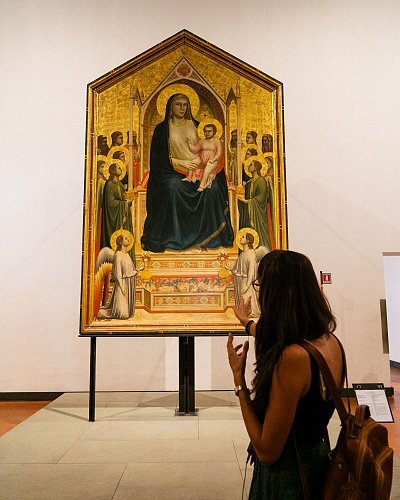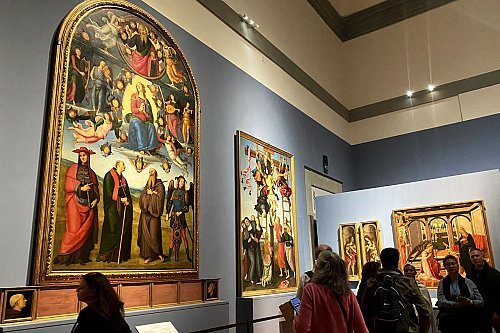Giotto and Giotteschi's Room

Giotto from the 14th century
Room XV contains works by followers of Giotto from the 14th century. The great Florentine artist had refreshed painting in the area by introducing a more naturalistic style of rendering. Giovanni Villani, a contemporary chronicler, describes him as "the most sovereign master of painting in his time: which drew all his figures and their postures according to nature." Of the works exhibited in this room, the only actual work by Giotto is a small fragment from a detached fresco coming from the Badia Fiorentina, which is the oldest Florentine abbey. This fragment contains an extraordinarily well-painted head of a shepherd, thanks to which it has been possible to date the painting to around the 1320s.
There were also among Giotto’s pupils one Bernardo Daddi, who painted several gold-ground panels in the room where it is to-day, notably a large cross formerly in the Florentine church of San Donato in Polverosa. The crucifix was placed over the high altar and presents the Gothic conventional representation of a “Christus patiens,” following faithfully the iconographic standards set up by Giotto with his crucifix for the Basilica of Santa Maria Novella in Florence around 1295. In Daddi's Crucifix, c. 1345, the great figure of Christ is flanked by the sorrowful presences of Mary and John the Evangelist while below are depicted scenes from "The Mocking of Christ," "Christ at the Column," and "The Way to Calvary." At the very top of the panel, within a luminous almond-shaped area, Jesus is shown as "Jesus Pantocrator at the Last Judgment." Also running across that same arm of the cross is a Latin inscription that reads "DICEST IESUS NAZARENUS REX IUDAEORUM."
In the hall, you can also take a look at the works of Taddeo Gaddi, one of the most eminent followers of Giotto. Taddeo spent about twenty-four years in Giotto's workshop and emerged as one of his closest disciples in Florence. It contains an interesting series of trefoiled panels on Stories from the Life of Christ and St. Francis of Assisi, which formerly adorned the Basilica of Santa Croce in Florence, probably attached to wooden choir stalls.
The paintings in the Giottesque room are of small format and were portable sacred images for personal worship, which at one time accompanied travelers– merchants and pilgrims on their dangerous voyages. Frequently, donors would place their safe journey under the protection of Virgin Mary or certain Saints of special veneration, chosen typically on the basis of the name of the patron.

